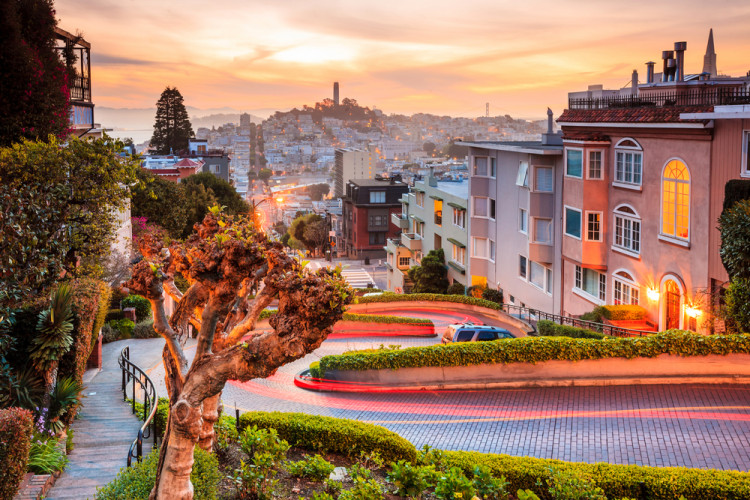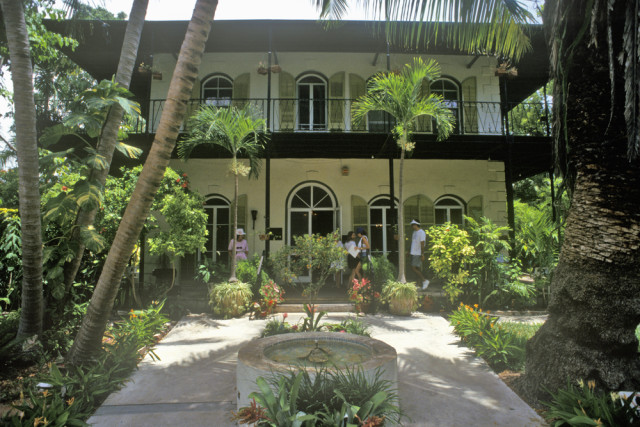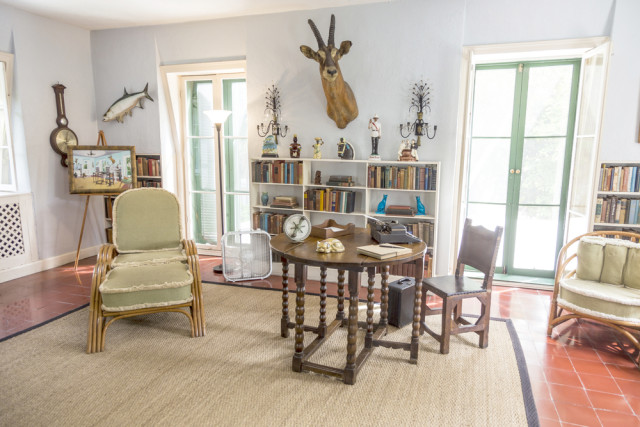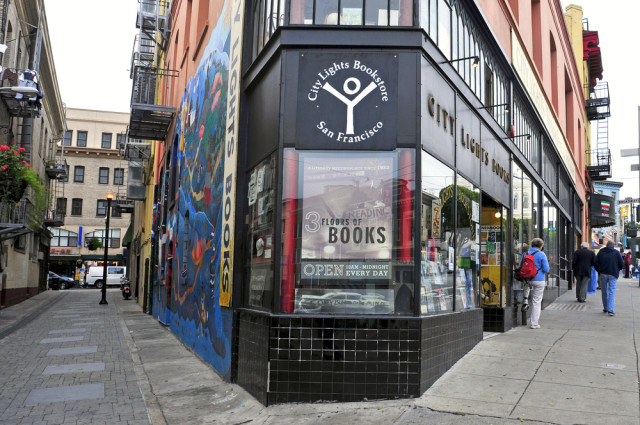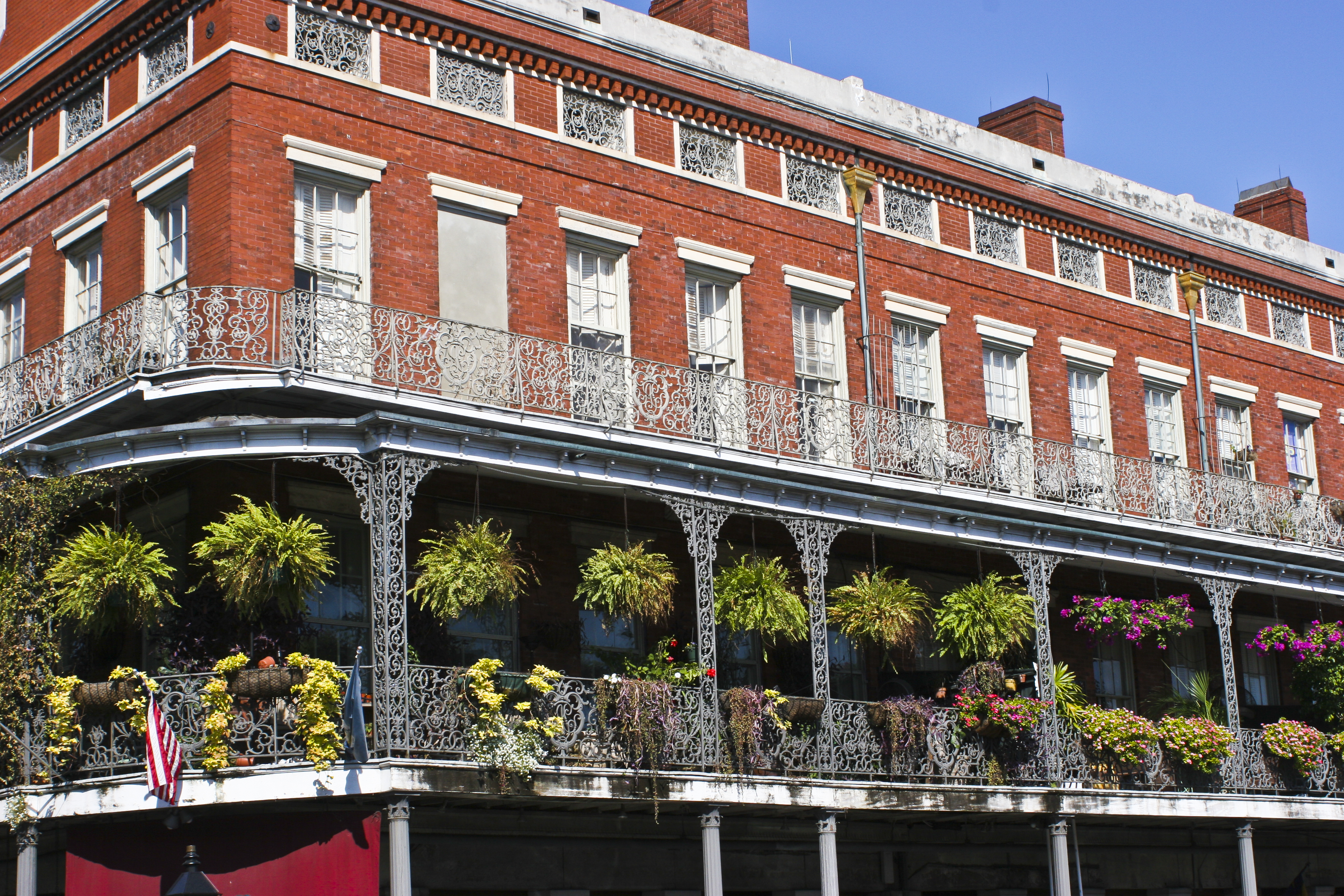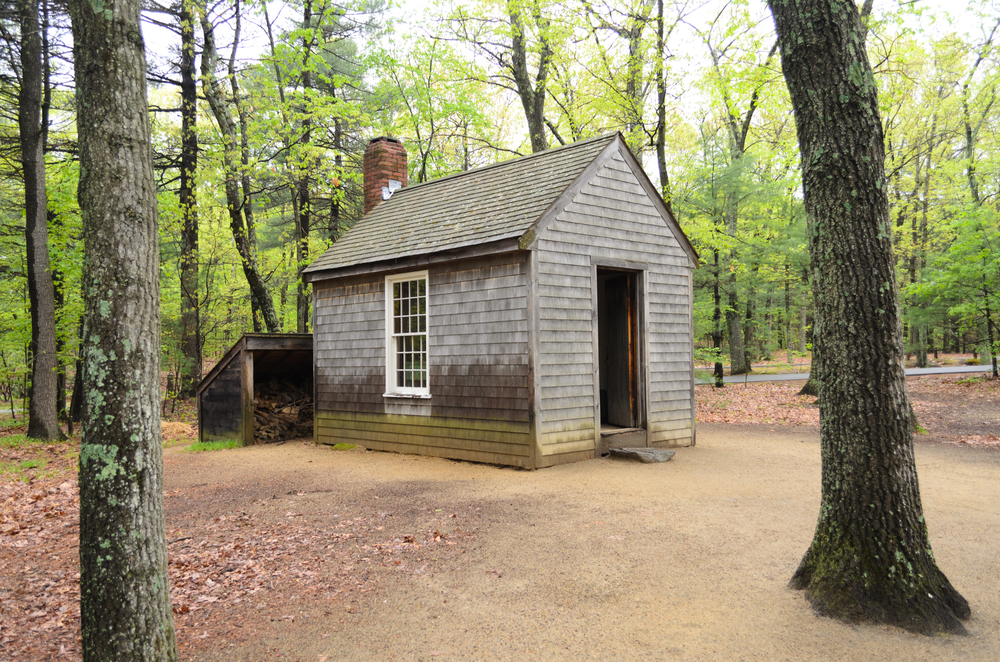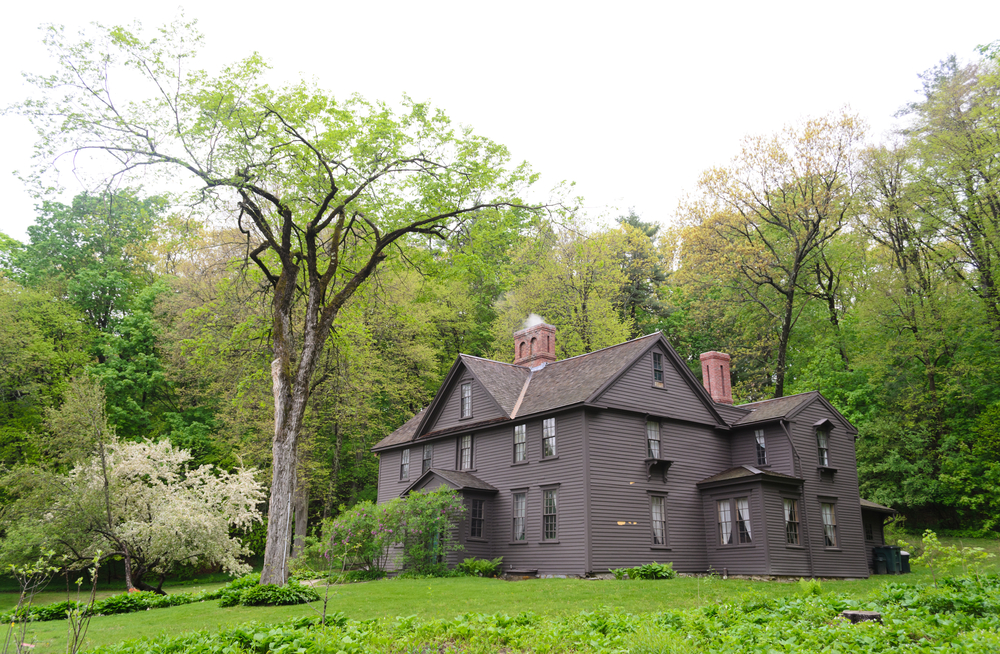Image of Lombard Street in San Francisco via Shutterstock
BY VICTORIA GAFFNEY
Long after we close the cover of a book, the stories that linger in our minds are often those firmly rooted in place. Setting is more than simply a backdrop for characters; the details and images of the physical environment can drive a plot forward, taking the reader on a dynamic journey through the narrative.
When I read, I’m drawn to thinking about not only where the stories are set, but also where they were penned. Did the sound of the novelist’s typing intermingle with horns honking along busy streets or the rhythmic crashing of ocean waves breaking along the shore?
Authors have hurried around the hectic streets of New York City, drifted about sleepy southern towns, and roamed around serene Mid-western prairies for centuries. Wherever you go in the U.S., chances are a writer has spent some time setting thoughts down on paper or simply passing through. Four U.S. towns and cities have particularly rich heritages, establishing themselves as magnets for the past, present, and future community of letters.
KEY WEST
Image of Ernest Hemingway Home and Museum working room via Shutterstock
Key West, with its white beaches and crystal blue waters, may have a quintessential tourist appeal, but this island city located at the southernmost part of Florida can hold its own as a literary mecca. Ernest Hemingway is most commonly associated with Key West, but it was John Dos Passos—a fellow ex-pat artist of the 1920s “Lost Generation” in Paris—who encouraged Hemingway to visit the city in the first place, explaining that it “looked like something in a dream.”
According to the story, Hemingway first visited Key West in 1928 with his new wife Pauline. Her uncle Gus Pfeiffer had bought them a car, but the vehicle took three weeks to turn up, and the Hemingways stayed at an apartment on Simonton Street—where Hemingway finished “A Farewell to Arms.” While in Key West, Charles Thomson, who owned a nearby hardware store, introduced Hemingway to deep-sea fishing. Hemingway developed a passion for the sport and went on frequent fishing trips with Thompson, Joe Russell (known as “Sloppy Joe”) and others. His group became known collectively as “The Mob” and they gave the boisterous, confident writer his famed nickname “Papa.” Hemingway went to Russell’s saloon for years and encouraged him to name it “Sloppy Joe’s.” The bar is still there today, complete with an annual Papa look-alike contest.
In 1931, Hemingway and his wife Pauline moved to 907 Whitehead Street. The Hemingways renovated the 1851 Spanish Colonial style home during the 1930s. One of the additions was Key West’s first in-ground pool. The cost of the pool was so steep that Hemingway is rumored to have placed a penny in the cement, exclaiming, “Here, take the last penny I’ve got!” The coin is still in the cement today. Papa’s former home is now known as The Ernest Hemingway Home and Museum. Inside the house, visitors can see the Hemingways’ European treasures from their time abroad and the writer’s studio. Perhaps the quirkiest sight for literary fans, however, is the collection of live cats. The felines roaming the property are allegedly descended from Hemingway’s six-toed cat, “Snowball.” To lend some credence to the theory, a lot of the cats at the house still have the curious six toes.
Image of Ernest Hemingway’s working room via Shutterstock
Hemingway may have been the most outgoing writer to live in Key West, but there were many others who called the island their home for some time. Tennessee Williams first began to visit Key West in 1941 and bought a house in 1949. In reference to his fondness for the island he stated curtly, “I like to swim.” Williams’ House is the antithesis of Hemingway’s—unassuming and small, a bungalow now privately owned on 1431 Duncan Street. Although travelers cannot go inside, it has an inconspicuous charm.
Poets Wallace Stevens and Robert Frost regularly wintered in Key West at Casa Marina, a building featuring Mediterranean Revival Architecture and now a resort. Fellow poet Elizabeth Bishop resided in Key West for a number of years as well. Both Stevens and Bishop kept to themselves and were much less gregarious than Hemingway and his mob. Like Hemingway, however, Stevens opposed the Federal Emergency Recovery Act that was slated to make Key West into a more commercial destination. Stevens’ first two books of poetry, “Harmonium” and “Collected Poems,” feature vivid Key West imagery. Williams, in fact, so admired Stevens’ poem “The Idea of Order at Key West,” that it was read at Williams’ funeral.
Hemingway may no longer be causing a raucous at “Sloppy Joe’s,” but the literary energy of Key West is still palpable. Each January there is a “Key West Literary Seminar,” where contemporary authors come for a celebration of writing, and every July there is a “Hemingway Days Festival” (an event spanning several days that features book readings and signings as well as a marlin tournament).
Many guides recommend bike tours around the island. One helpful resource is Gail Duerfeldt Hinand’s “Haunts and Homes: a tour of Key West writers’ history,” which includes her interactive map of literary sites. Tourists can fish Hemingway-style at Angler Central or swim like Tennessee Williams through the refreshing waters, and even take their bookish retreat up a notch by staying at the Authors of Key West Guest House. Of course, a trip to Key West is incomplete without immersing yourself in the literature of this island suffused in tropical breezes and surrounded by pale blue waters. “The Key West Reader: The Best of the Key West’s Writers, 1830-1990” is a great resource for anyone looking to dive into the writings of Bishop, Hemingway, Stevens, and Williams.
SAN FRANCISCO
Image of City Lights Bookstore via Shutterstock
When I think of literature and the Bay Area, I often see an image of offbeat, bohemian artists and writers rebelling against social norms and embarking on spiritual journeys. This group of 1950s authors, known as the Beat Generation and concentrated in San Francisco, played with form and narrative. They experimented with and explored different perspectives, always rejecting conformity and embracing a freethinking experience. Jack Kerouac’s “On the Road,” Allen Ginsberg’s “Howl,” and William S. Burroughs’s “Naked Lunch” are well-known examples of this literary tradition. Burroughs’s and Ginsberg’s novels became notorious for their explicit material and subsequent obscenity trials, which paved the way for more open-minded publishing standards.
Today, tourists can meander down Jack Kerouac Alley in Chinatown where poems by Maya Angelou, Steinbeck, and Kerouac, as well as some Chinese poems, are carved into plaques. Around the corner is “City Lights Bookstore,” a beloved indie bookstore, a place where writers have been congregating since the 1950s, including Kerouac himself.
The beats certainly helped to establish San Francisco as a city for creative types, but they aren’t the foggy city’s only legacies. Before Kerouac and Ginsberg, Jack London planted roots in the Bay Area. A replica of the cabin he lived in during the Klondike Gold Rush in the 1800s can be found at 466 Water St. in Oakland near Jack London Square. For a drink, people can stop in “Heinhold’s First and Last Chance Saloon” one of London’s haunts where he penned ideas for “The Call of the Wild.”
Today, San Francisco still has a vibrant writing culture. A nine-day festival, Litquake, is held in the city each October offering locals and visitors an immersive experience. For an everyday activity, travelers can grab some coffee at Kerouac and Ginsberg’s old place, Vesuvio Café–where the walls are adorned with allusions to the beats–or eat at John’s Grill–where the “The Maltese Falcon” protagonist Sam Spade fictionally dined. It can also be fun to trace Spade’s footsteps throughout the city. Staying at Hotel Rex will satisfy any fan of the beats with its 1920s saloon-like interior, bookish bar, and weekly jazz. To help make the most of a literary-themed trip to San Francisco, “The San Francisco Chronicle” came out with a helpful interactive map of the city a few years ago. Of course, reading “On the Road” before a trip to San Francisco is never a bad idea too.
NEW ORLEANS
Image of New Orleans French Quarter via Shutterstock
Tennessee Williams may have spent time in Key West, but the city with the greatest initial influence on his works was New Orleans, which he described as being among “the last frontiers of Bohemia.” “A Streetcar Named Desire” was set in this southern city and every year there is a Tennessee Williams Literary Festival that includes a Stella shouting contest.
Sherwood Anderson lived in the famed red brick Pontalba Apartments, which people still visit and rent. Anderson, Edna St. Vincent Millay, and William Faulkner (whom Anderson mentored) gathered at these apartments during the 1920s. Truman Capote, who was born in New Orleans, described them in “Hidden Gardens” as “the oldest, in some ways most somberly elegant, apartment houses in America.” Faulkner also stayed in the French Quarter briefly at what is now known as Faulkner House Books, an independent bookstore. The vibrancy of this area left an impression on Faulkner, who wrote about the city in his collection, “New Orleans Sketches.” Before the 20th century modernists, Kate Chopin resided in the city for some time in the 1870s and her groundbreaking novel “The Awakening” is set in New Orleans.
In the 1960s, John Kennedy Toole wrote “A Confederacy of Dunces,” which takes place in New Orleans. Although not published until 1980, Toole captures the vibrancy of the French Quarter in this satirical novel, particularly with his use of the “Yat” accent (which incorporates Southern American English with European accents such as Irish, German, and Italian). A statue of the protagonist, Ignatius Reilly, stands on Canal Street, serving as a reminder of Toole’s influential work.
Like Key West, people can bike around New Orleans to see the literary landmarks. Bikes are available for rent at “A Bicycle Named Desire,” located at the fictional address of Stanley and Stella. One spot to see along the way is the famous Hotel Monteleone, where Hemingway, Williams, Faulkner, and others stayed at various points—a display in the window features books penned at the hotel. Travelers can stop at the Carousel Bar and Lounge inside the hotel and sip a Sazerac cocktail as some of the writers were known to do. Backspace Bar And Kitchen is a great option for a nerdy bar night, while Galatoire’s–one of Williams’ favorite spots–is a historical and tasty option for dinner. As with the other cities, strolling (or cycling) passed some authors’ houses (such as Chopin’s and Williams’) is always a fun possibility. Reading Faulkner’s “New Orleans Sketches,” Chopin’s “Awakening,” or even “A Confederacy of Dunces,” will give the tourist a leg up in understanding the rich history and culture of this southern city.
CONCORD
Image of Henry David Thoreau cabin replica via Shutterstock
In some ways, Concord, Massachusetts is the most literary town in the U.S. In 1835, Ralph Waldo Emerson moved to the small town outside Boston, paving the way for other writers, including Henry David Thoreau, Louisa May Alcott, and Nathaniel Hawthorne. Concord calls to mind peaceful and serene images of nature: solitary walks through the woods and strolls along quiet streams. It’s no surprise that this town was the chief hub for transcendentalists—the 1800s philosophical and religious movement centered on Emerson and Thoreau that focused on the individual and nature. The steady flow of authors into Concord left several of their houses with intriguing, overlapping histories.
The transcendentalist movement can be said to have started at one house in particular, “The Old Manse,” built for Emerson’s grandfather in 1870. In 1834, Emerson moved into this house nestled near the Concord River, a few steps from the “Old North Bridge” where the “shot heard round the world” echoed in 1775 to sound the beginning of the American Revolution. Emerson lived at “The Old Manse” for a year; it was here that he wrote the preliminary draft of the foundational transcendentalist essay “Nature.” Emerson then moved into The Ralph Waldo Emerson House with his wife Lydia (whom he called “Lidian”) in 1835. He would remain at this house for the rest of his life—with the exception of a brief return to Old Manse after a fire at the Emerson House damaged the roof and some of the second floor. Emerson wrote his essay “Self Reliance” at the Emerson House, and over the years the home became a hub for transcendentalist thinkers, where people would flock to visit the man known as “the sage of Concord.” Today, most of the inside of the house appears as it did when Emerson resided there, but the former contents of his study are now in the Concord Museum across the street.
Emerson and Henry David Thoreau met sometime in the 1830s and they quickly struck up an intellectual friendship, with Emerson adopting a mentoring role towards Thoreau. Thoreau was born in Concord and then attended Harvard. He lived with Emerson at the Emerson House from 1841 until 1844. While there, Thoreau gardened and helped around the property while also continuing to serve as Emerson’s protégée.
In 1845 Thoreau memorably wrote in his journal, “July 5, 1845. Yesterday I came here to live,” marking the beginning of his two-year stay in a one-room cabin in the woods, which became the material for his famous work, “Walden.” Today, people can still visit this setting at the placid waters of Walden Pond—although the cabin is no longer there, there is a model nearby, and the original furnishings are in the Concord Museum.
Thoreau moved back to Emerson’s house for a year in 1847. Their relationship became more fractious over the years, with Emerson saying at Thoreau’s funeral, “I love Henry, but I cannot like him; and as for taking his arm, I should as soon think of taking the arm of an elm-tree.”
Nathaniel Hawthorne and Sophia Hawthorne moved into “Old Manse” in 1842 shortly after their marriage. Thoreau had planted a vegetable garden for them, which has been reimagined on the property. Visitors can still see the notes that the newlyweds carved to each other in the windowpanes. Hawthorne was relatively quiet and kept to himself, but he enjoyed going for rides with Thoreau in the latter’s handmade boat, the Musketaquid. Hawthorne eventually purchased the boat, but recognized his shortcomings in being able to navigate it, saying, “I wish I could acquire the aquatic skill of the original owner.”
Image of Louisa May Alcott’s House, “The Orchard” via Shutterstock
The Hawthornes moved away from Concord after three years, but returned to the quiet town the next decade. In 1852, they purchased “Hillside”–where Louisa May Alcott lived from 1845 until 1852– renaming it “Wayside.” They resided in England from 1853 until 1860, but returned to the “Wayside” where Hawthorne would stay until his death in 1864. His wife and their three children moved back to England after his death and sold the house in 1870. After Louisa May Alcott left “Hillside,” she moved next door to “The Orchard,” where she lived from 1858 until 1877 and wrote “Little Women.”
Emerson, Hawthorne, Thoreau, and Alcott are all buried in the Sleepy Hollow Cemetery. Usually pencils, pens and stones lie scattered around their graves.
As with the other cities, walking around Concord is a great way to revel in the nature that inspired the great transcendentalist minds. The Concord Museum offers self-guided tours. Every fall, there is the Concord Festival of Authors, which is a celebration of contemporary writers and a “New Literary Voices” program that promotes new authors. Travelers can stay at Concord’s Colonial Inn, the very place Thoreau stayed when he was a Harvard student, and The Concord Bookshop is a great spot to pick up some of the works by these authors.
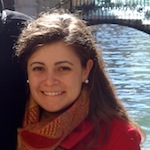 ABOUT THE WRITER
ABOUT THE WRITER
Victoria Gaffney is currently pursuing an MA in Nonfiction Writing at Johns Hopkins in Washington D.C. She is a graduate of Haverford College where she majored in English and developed a passion for words and stories. She enjoys traveling and engaging with new people and perspectives, and relishes the thrill of late nights spent reading a new book or huddling in front of a computer screen to write. In her free time, she can be found drinking copious amounts of coffee, playing with dogs, practicing yoga and wandering around new streets without a plan. Victoria hopes to use writing to help impact positive change. Follow her on Twitter.
